The 15-Minute City—The Geographical Proximity of Services in Krakow
Abstract
:1. Introduction
- How does proximity to services vary across Krakow?
- What percentage of Krakow’s residents can access specific facilities within 15 min?
- Which areas of the city provide access to a set of services that meets the needs of residents within a 15-minute walking distance? (minimal and optimal versions)
- Which areas are characterised by the largest deficits in the local provision of services?
2. Review of Research
- proximity—understood as a short physical distance to services, goods, equipment, buildings, and places that serve the needs of citizens;
- diversity—understood as 1. a comprehensive use of space in order to provide inhabitants with access to a wide range of services, goods and facilities offered by the city; and 2. multiculturalism;
- density—or the concentration in a given area of a sufficient number of residents to make it profitable to do business and provide a variety of public services;
- spatial (takes place in space), communicative (through a variety of media, including transport);
- temporal (takes place at a certain time or occupies a certain amount of time), and socio-cultural (concerns communities with different social characteristics, needs, opportunities and expectations);
- economic (requires effort—financial outlays, technical resources);
3. Materials and Methods
3.1. Study Area
3.2. Data Sources and Research Method
4. Results
4.1. Externalities of a 15-Minute City
4.2. The 15-Minute Krakow
- Figure A1. Nurseries
- Figure A2. Preschools
- Figure A3. Primary schools
- Figure A4. Secondary schools
- Figure A5. Primary health care centres
- Figure A6. Pharmacies
- Figure A7. Day-care centres for seniors
- Figure A8. Library
- Figure A9. Community centres
- Figure A10. Cultural venues
- Figure A11. Green areas with an area exceeding 2ha
- Figure A12. Playgrounds for children
- Figure A13. Public sports fields for team games
- Figure A14. Gyms, fitness clubs
- Figure A15. Indoor swimming pools
- Figure A16. Grocery shops
- Figure A17. Supermarkets
- Figure A18. Post offices
- Figure A19. Catholic churches
- Figure A20. Marketplaces
- Figure A21. Restaurants
- Figure A22. Pubs, bars, cafés
- Figure A23. Public transport stops (trams and buses)
- Figure A24. Tram stops
- Figure A25. Rapid transit/commuter rail stops.
5. Discussion
6. Conclusions
Author Contributions
Funding
Institutional Review Board Statement
Informed Consent Statement
Data Availability Statement
Conflicts of Interest
Appendix A

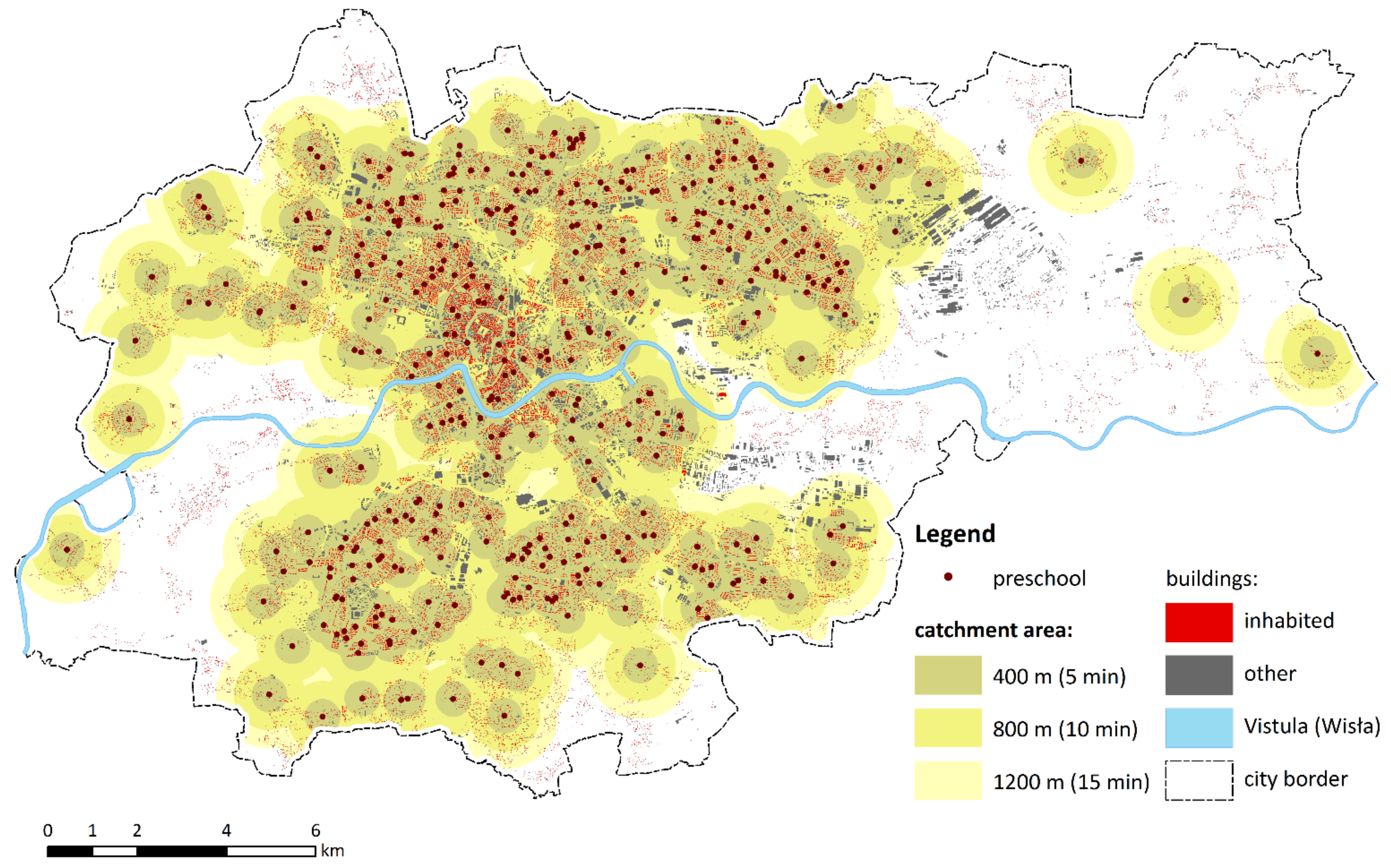
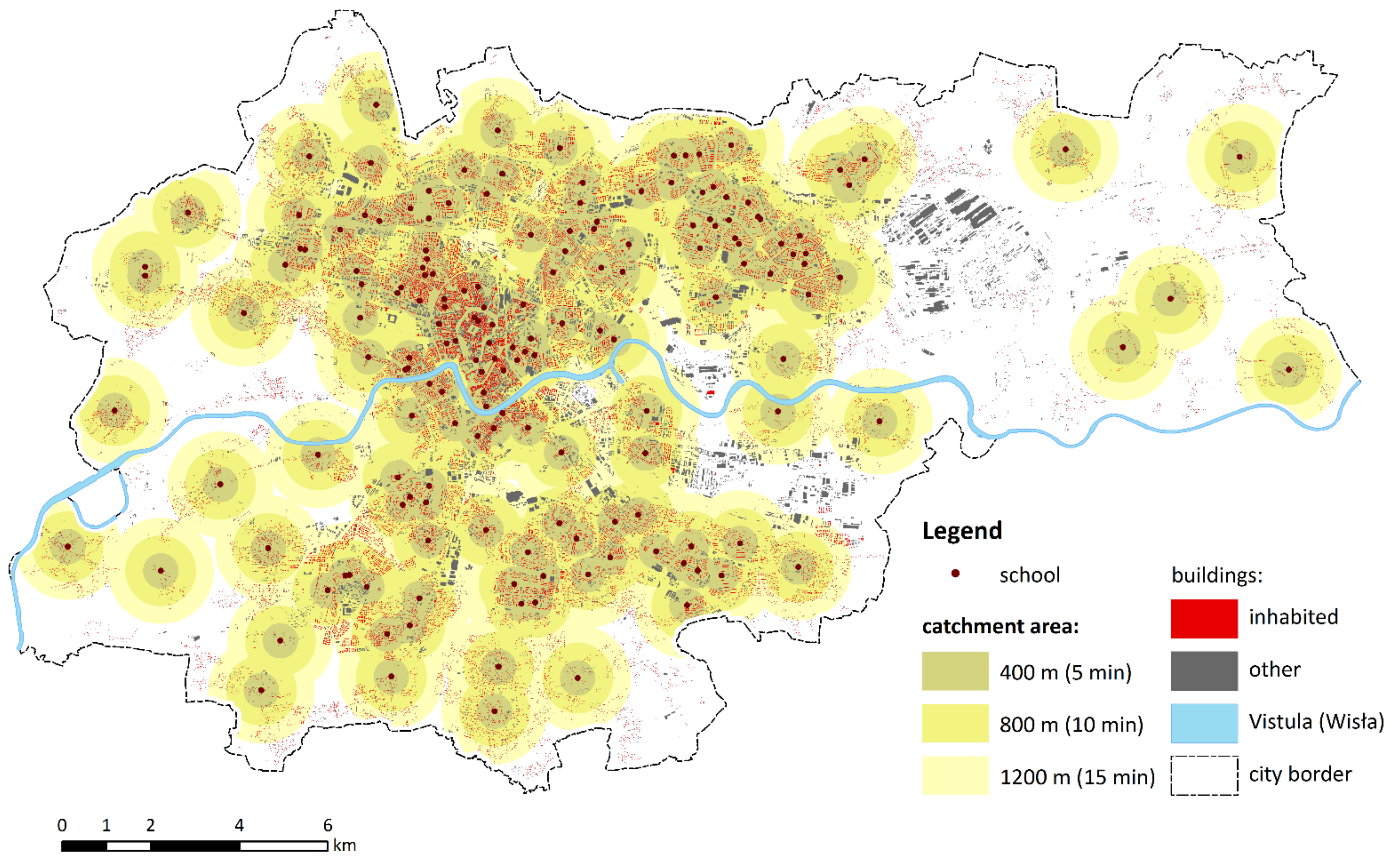
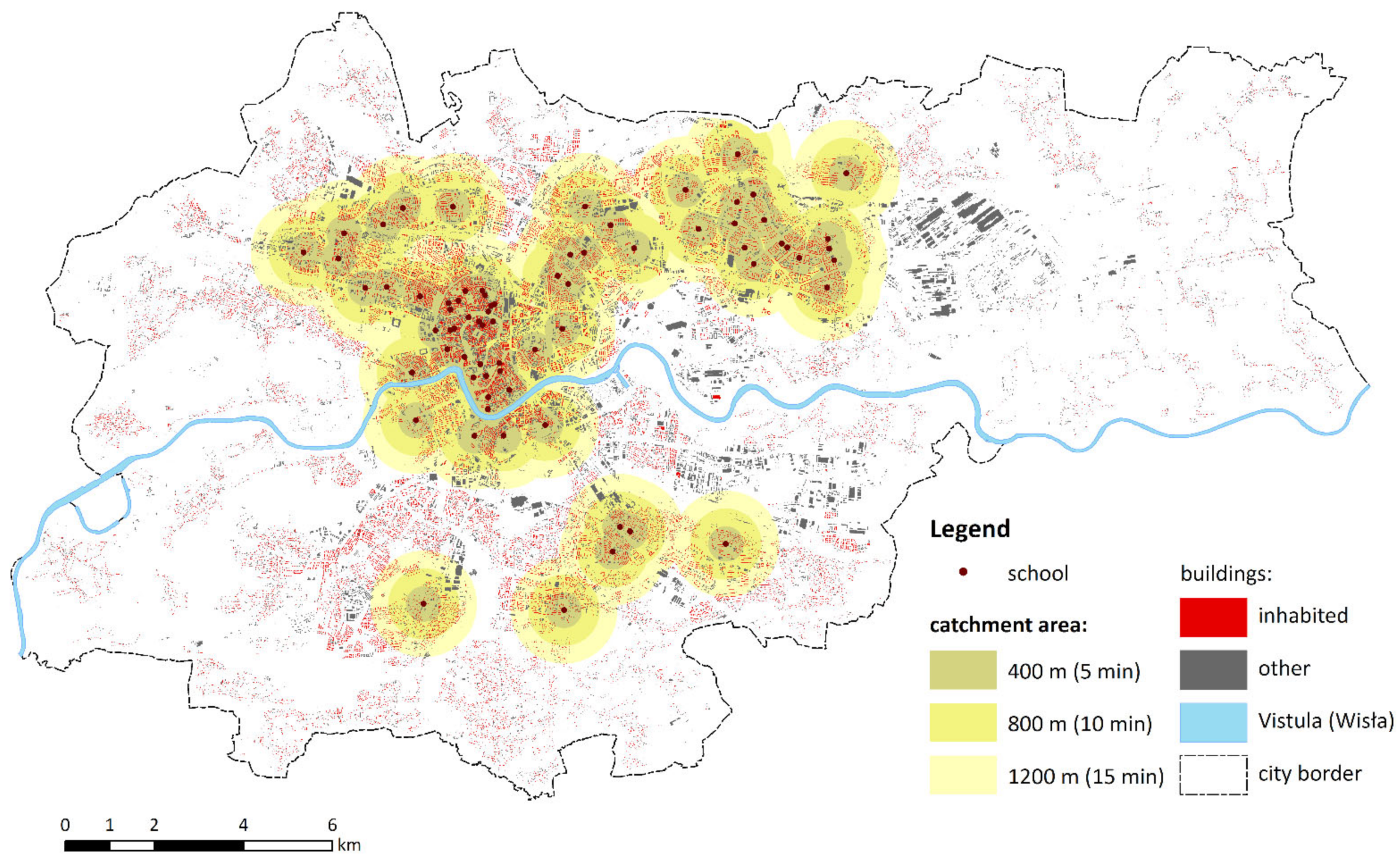
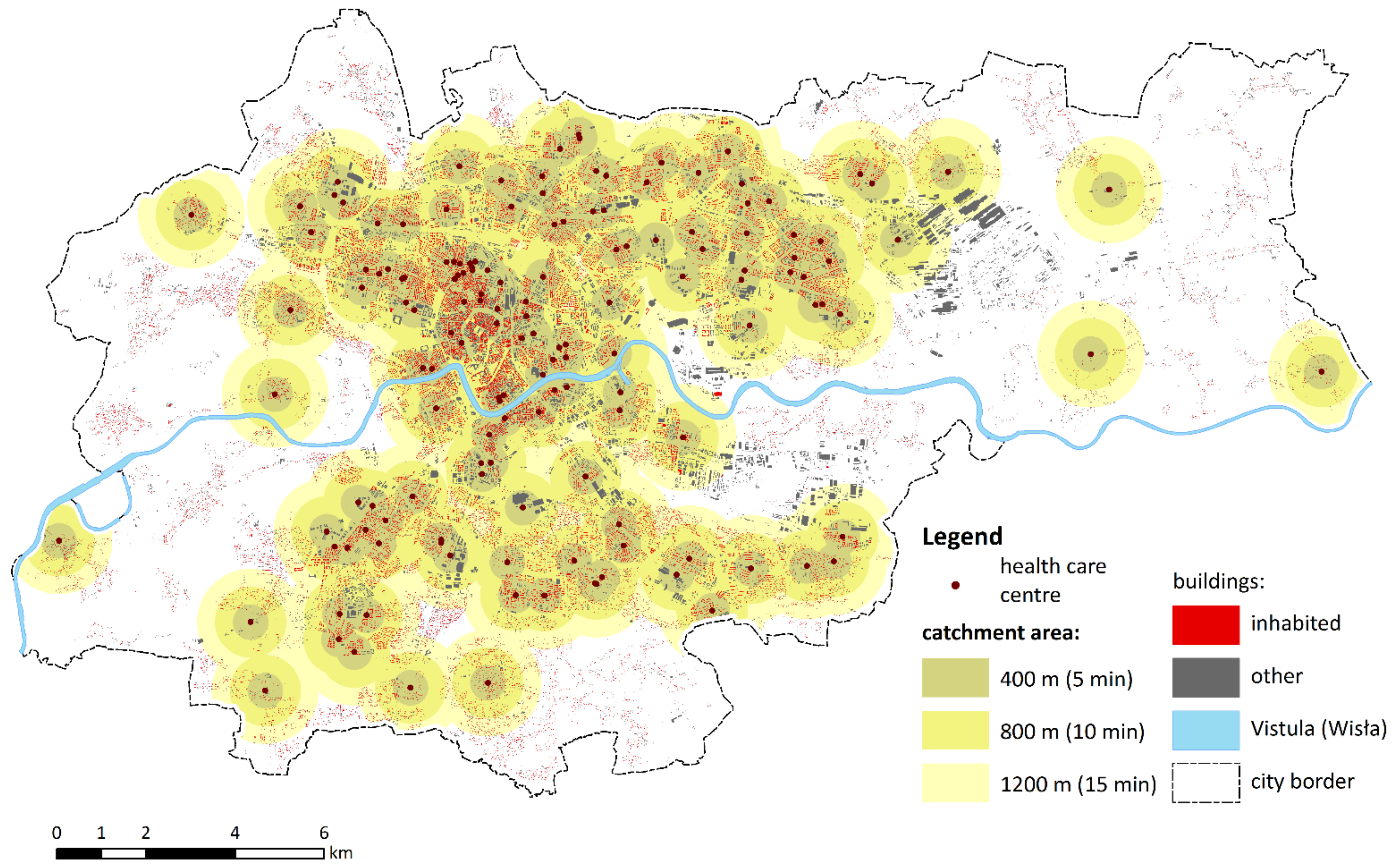
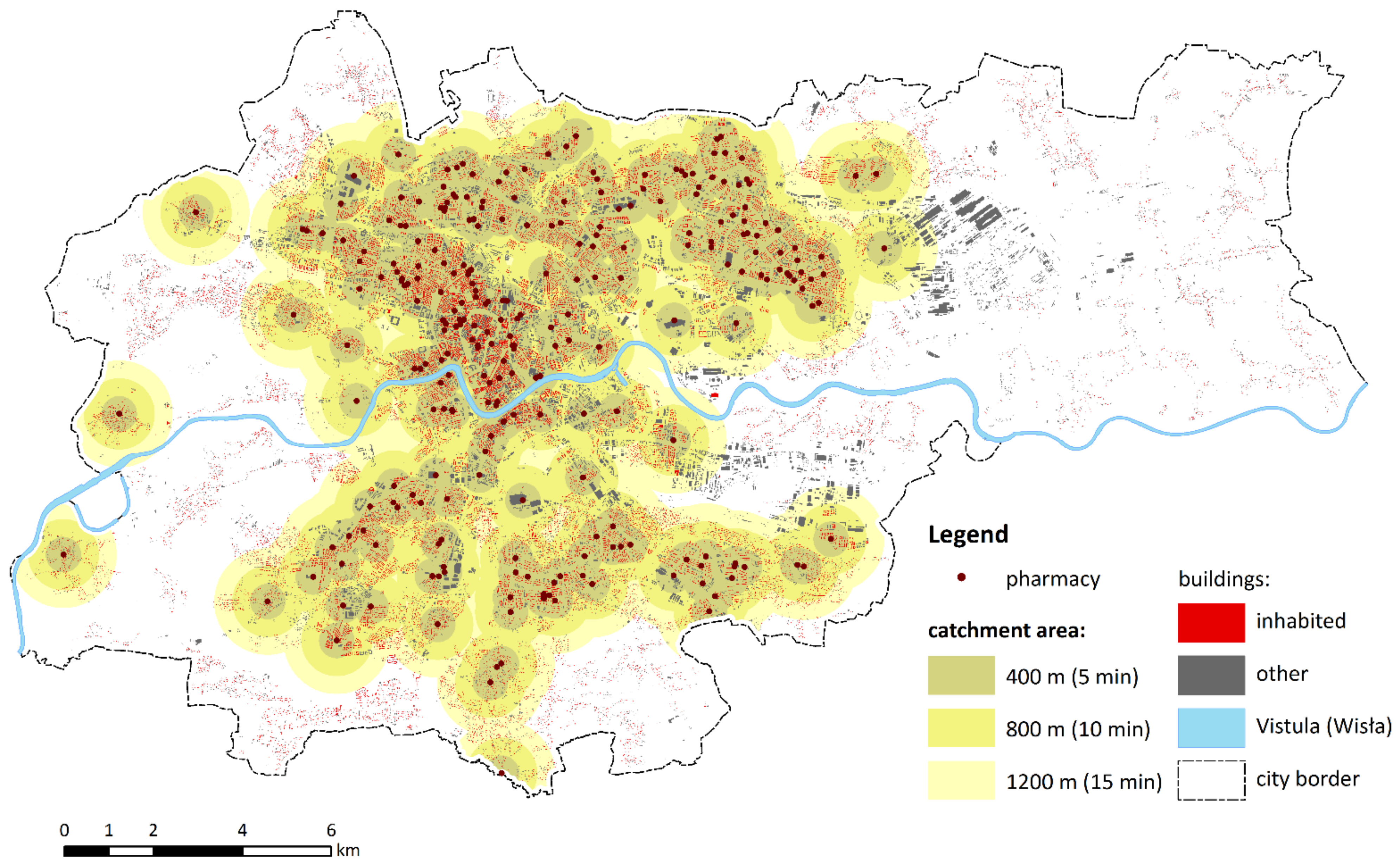
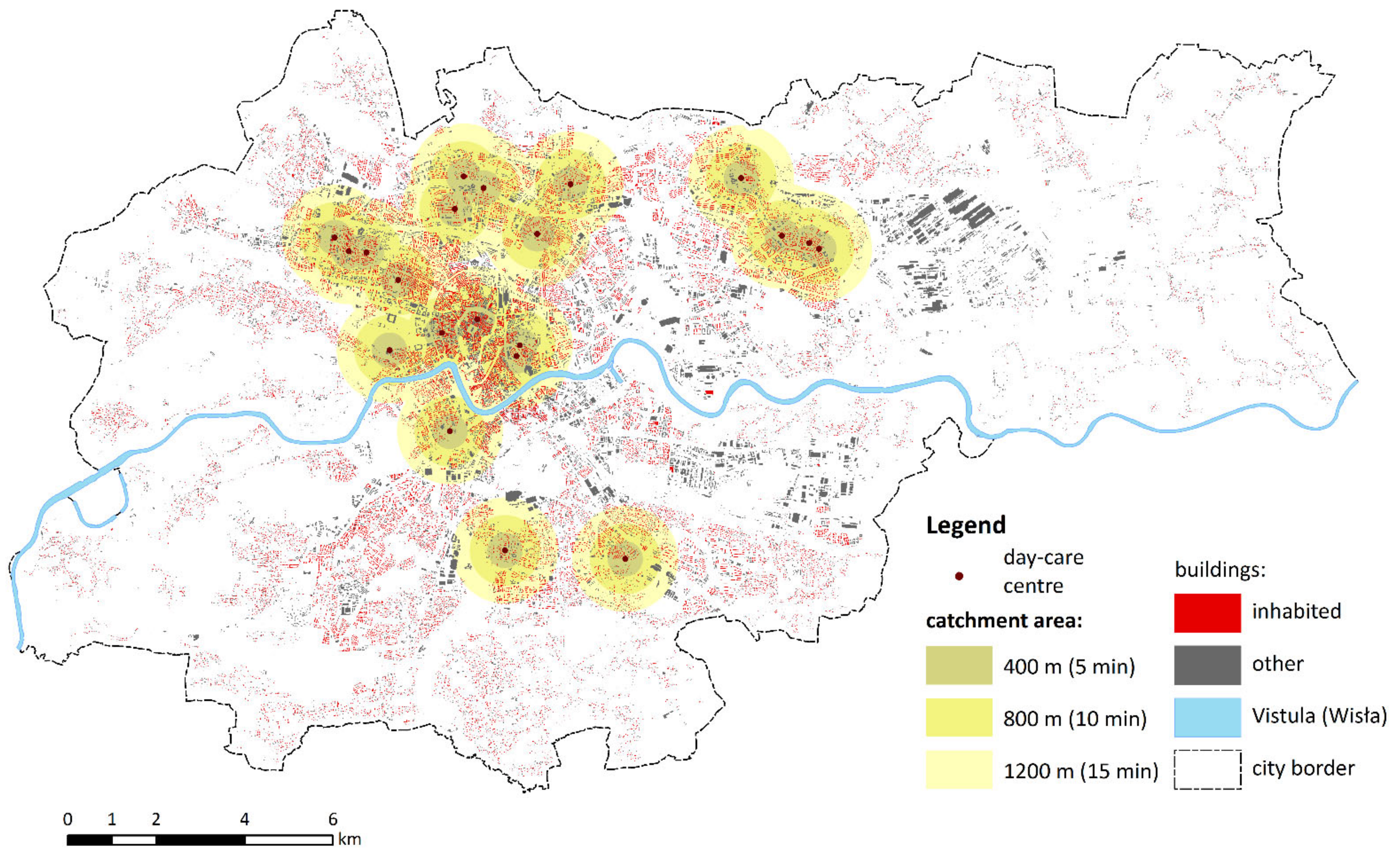

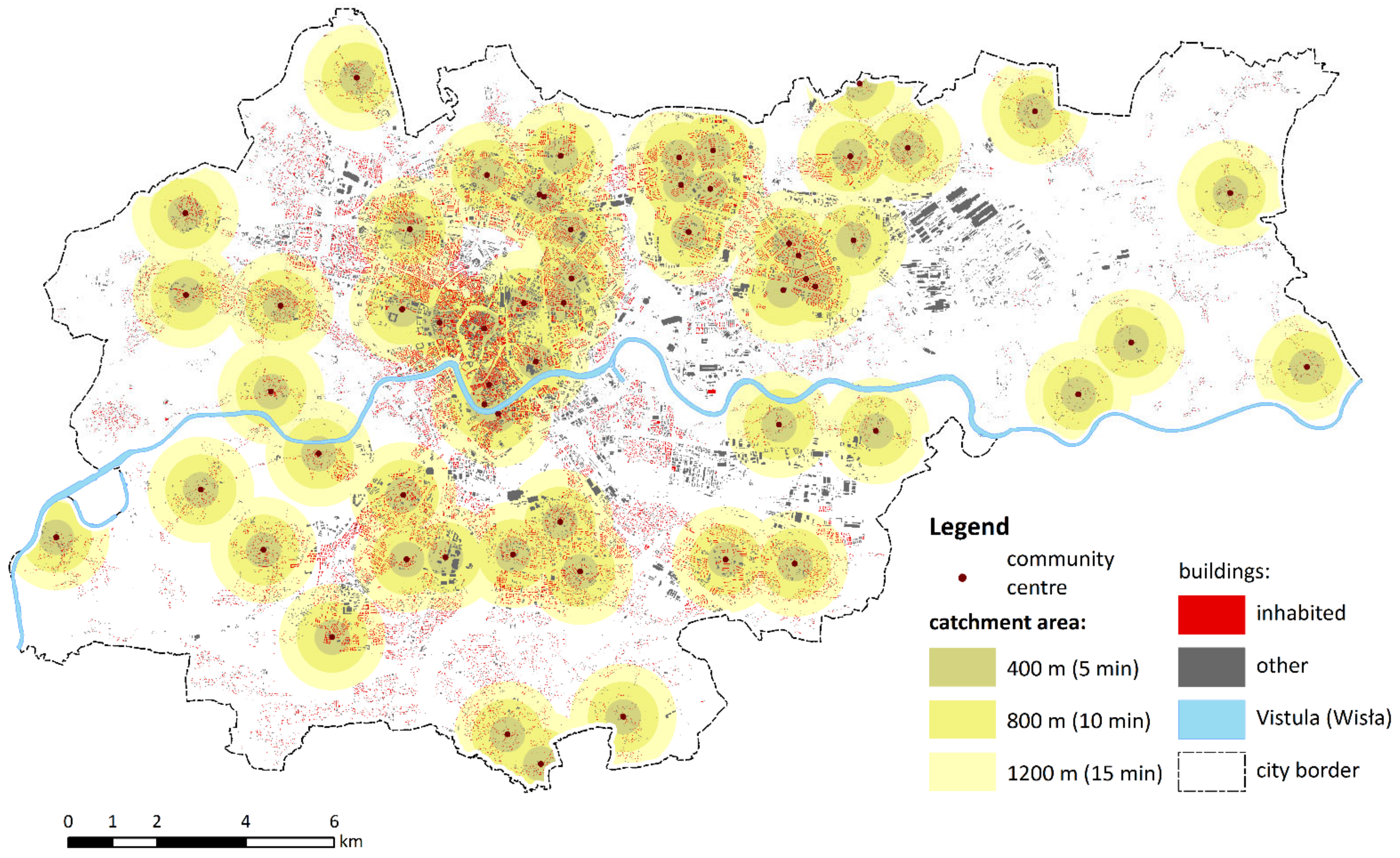

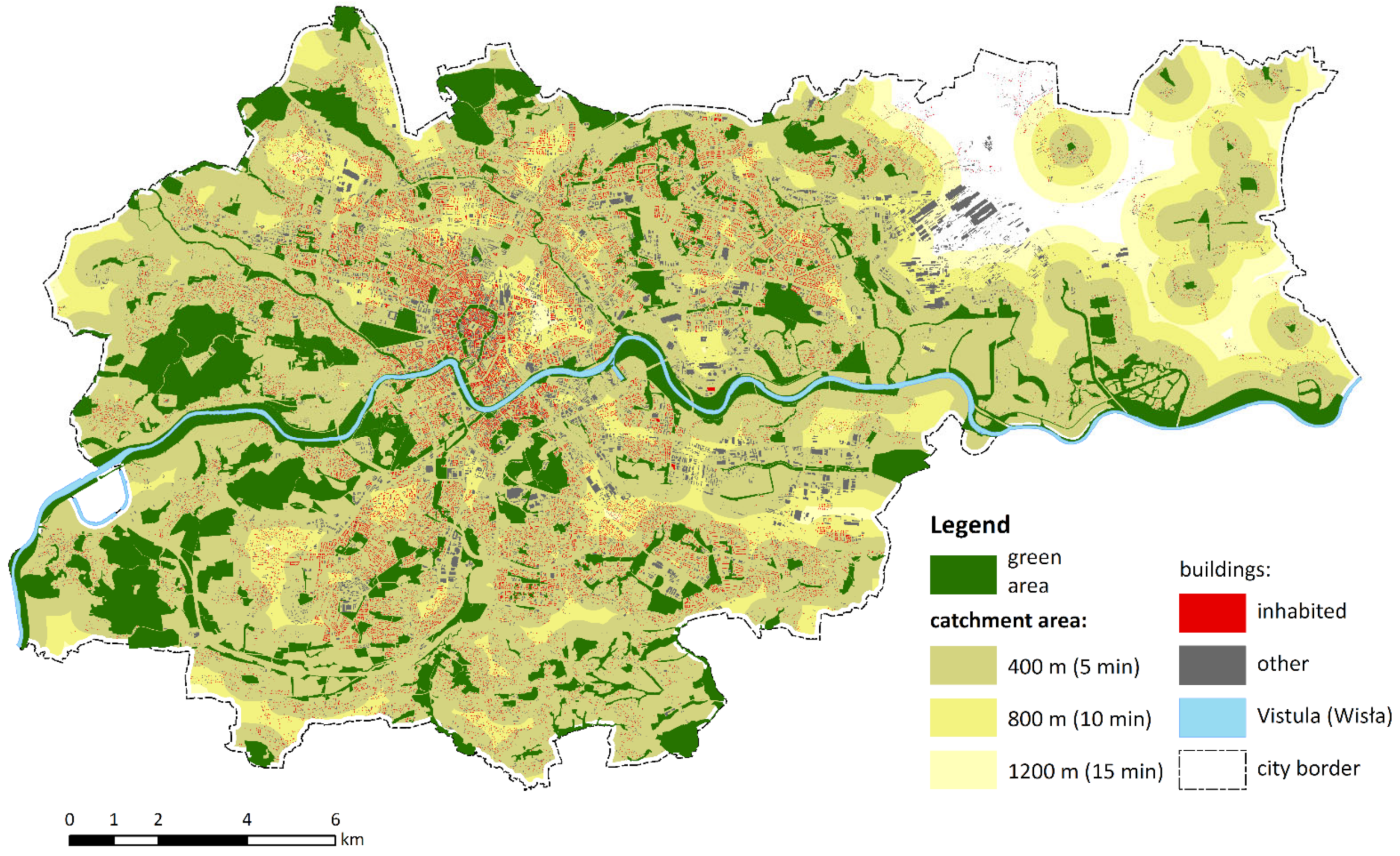

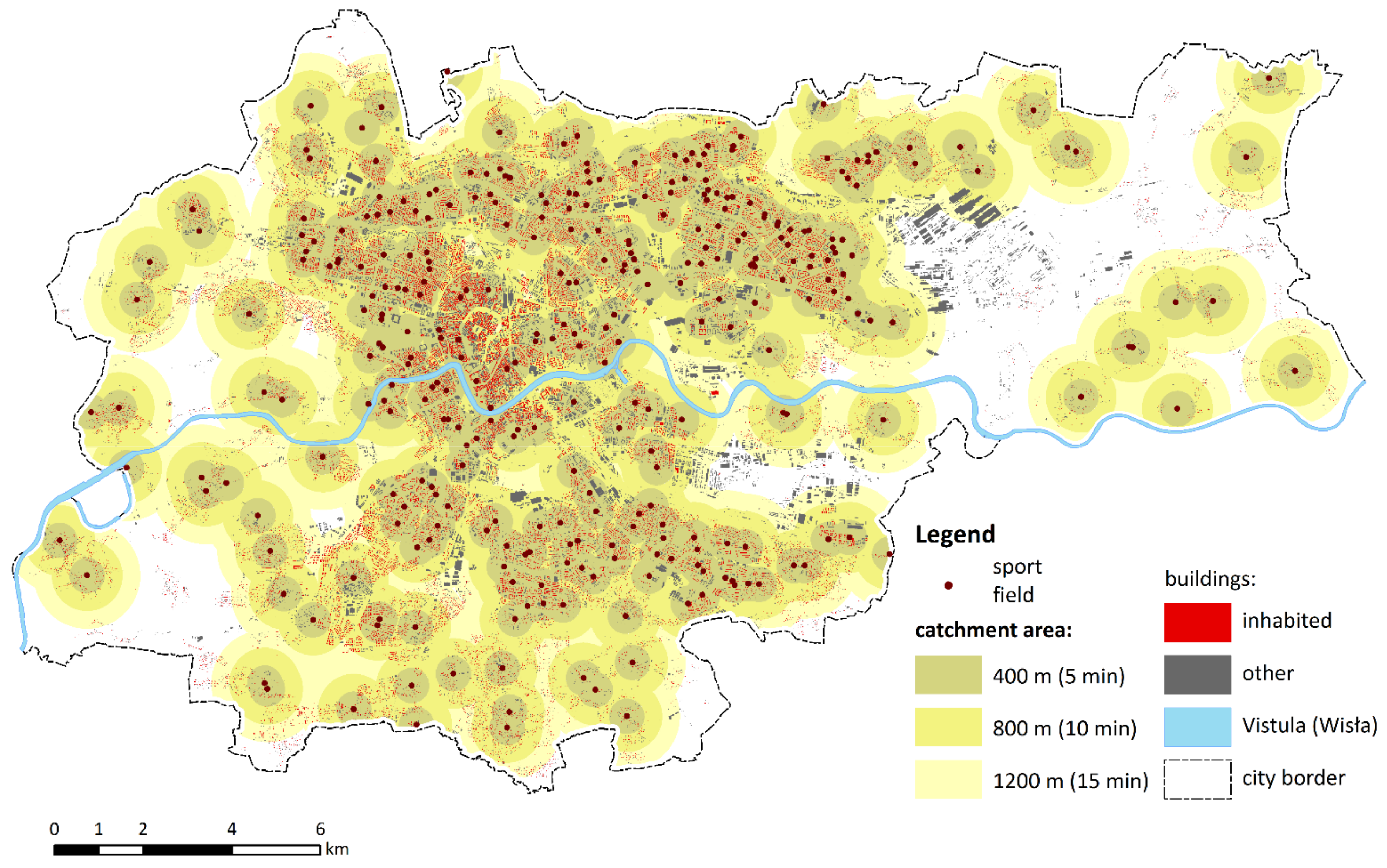






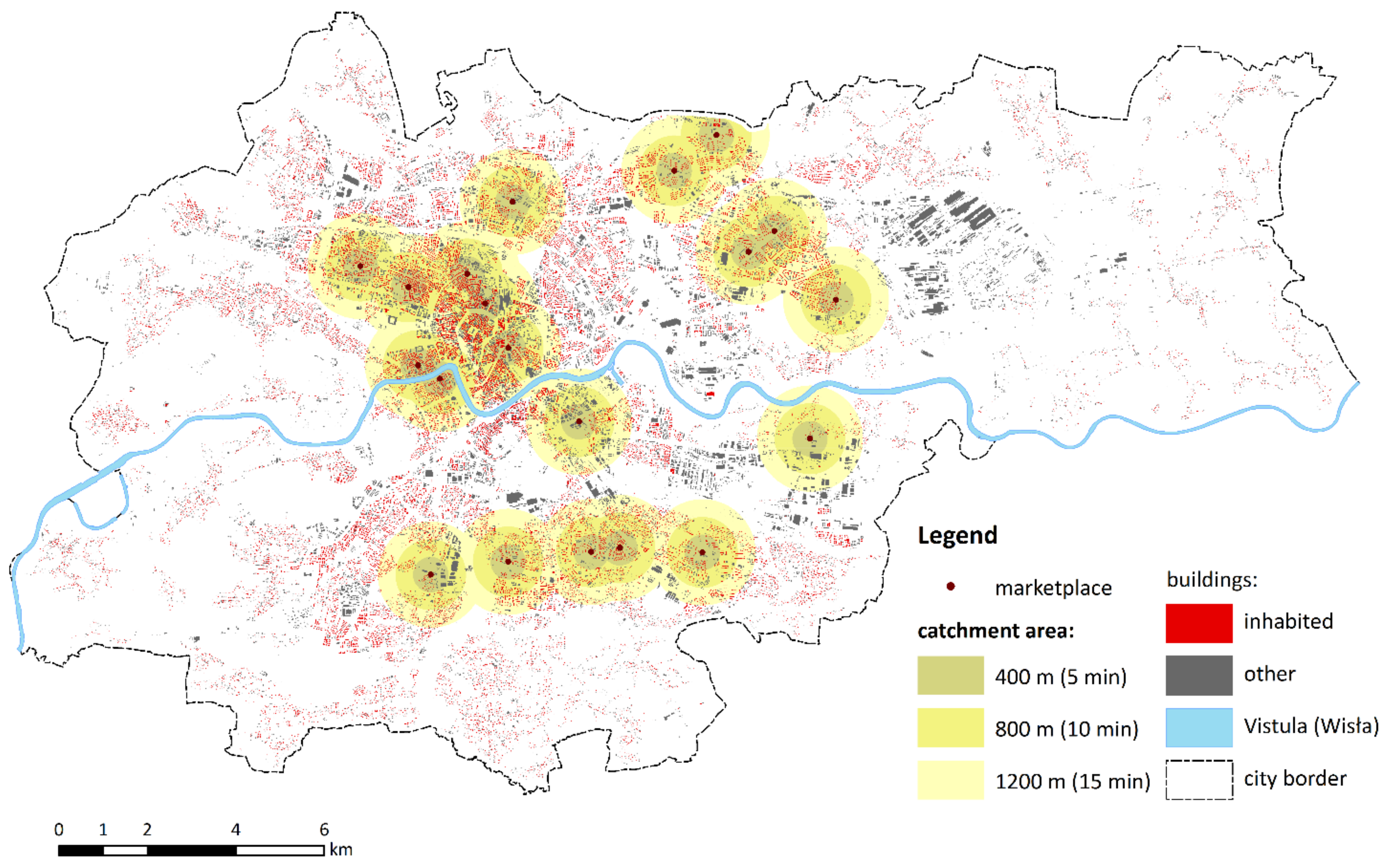

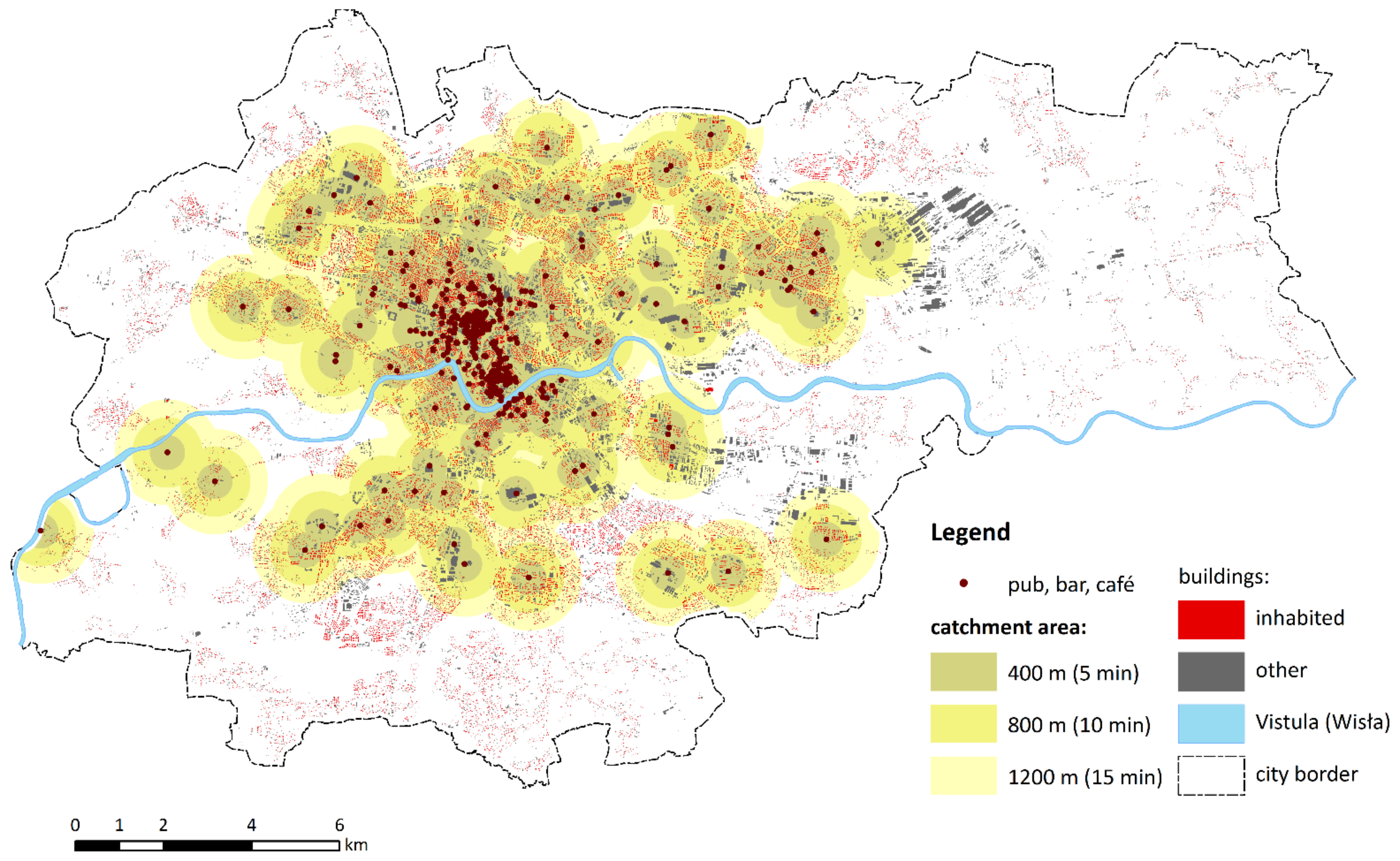


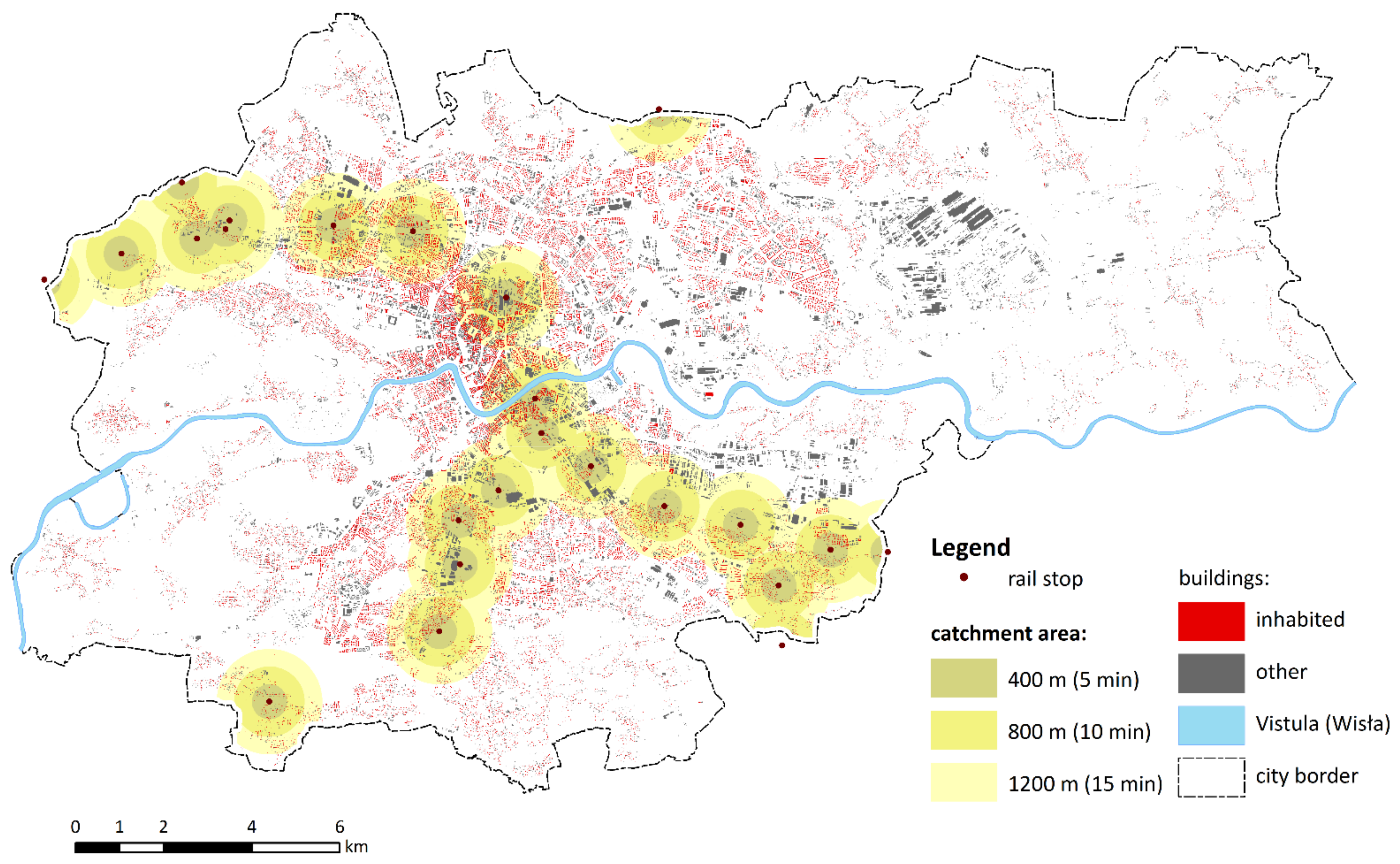
References
- Moreno, C.; Allam, Z.; Chabaud, D.; Gall, C.; Prationg, F. Introducing the “15-minute City”: Sustainability, Resilience and Place Identity in Future Post-Pandemic Cities. Smart Cities 2021, 4, 93–111. [Google Scholar] [CrossRef]
- A Collection Dedicated to the 15-Minute City; Entrepreneurship Territory Innovation Chair, Sorbonne Business School. Paris 1 Panthéon-Sorbonne: Paris, France, 2020. Available online: https://chaire-eti.org/wp-content/uploads/2021/01/15-minute-city-collection.pdf (accessed on 21 March 2022).
- Perry, C.A. Housing for the Machine Age; Russell Sage Foundation: New York, NY, USA, 1939. [Google Scholar]
- Jacobs, J. The Death and Life of Great American Cities; Random House Inc.: New York, NY, USA, 1961. [Google Scholar]
- Talen, E. (Ed.) Charter of the New Urbanism: Congress for the New Urbanism, 2nd ed.; McGraw Hill Professional: New York, NY, USA, 2013. [Google Scholar]
- United Nations. Transforming Our World: The 2030 Agenda for Sustainable Development (A/RES/70/1); United Nations: New York, NY, USA, 2015; Available online: https://sustainabledevelopment.un.org/content/documents/21252030%20Agenda%20for%20Sustainable%20Development%20web.pdf (accessed on 24 March 2022).
- United Nations. New Urban Agenda, Habitat III; United Nations: New York, NY, USA, 2016; Available online: https://habitat3.org/the-new-urban-agenda (accessed on 4 March 2022).
- The New Leipzig Charter. The Transformative Power of Cities for the Common Good, Adopted at the Informal Meeting of EU Urban Affairs Ministers on 30 November 2020. Available online: https://ec.europa.eu/regional_policy/en/newsroom/news/2020/12/12-08-2020-new-leipzig-charter-the-transformative-power-of-cities-for-the-common-good (accessed on 4 March 2022).
- O’Sullivan, F. Paris Mayor: It’s Time for a “15-Minute City”. Available online: https://www.bloomberg.com/news/articles/2020-02-18/paris-mayor-pledges-a-greener-15-minute-city (accessed on 11 March 2022).
- Open Streets. Strategies, Actions and Tools for Cycling and Walking, Ensuring Distancing Measures within the Urban Travel and Towards a Sustainable Mobility. Available online: https://www.comune.milano.it/documents/20126/7117896/Open+streets.pdf/d9be0547-1eb0-5abf-410b-a8ca97945136?t=1589195741171 (accessed on 11 March 2022).
- Nuestro Compromiso de Hacer de Buenos Aires Una Ciudad a Escala Humana. Available online: https://www.buenosaires.gob.ar/noticias/nuestro-compromiso-de-hacer-de-buenos-aires-una-ciudad-escala-humana (accessed on 11 March 2022).
- The Portland Plan. Prosperous. Educated. Healthy. Equitable. Available online: https://www.portlandonline.com/portlandplan/index.cfm?c=58776 (accessed on 11 March 2022).
- Plaza de Mercado Siete de Agosto. Available online: https://www.c40reinventingcities.org/en/students/winning-projects/plaza-de-mercado-siete-de-agosto-1450.html (accessed on 11 March 2022).
- Plan Policy. Available online: https://www.cltfuture2040plan.com/content/goal-1-10-minute-neighborhoods-0 (accessed on 11 March 2022).
- The New Official Plan. Available online: https://engage.ottawa.ca/the-new-official-plan/news_feed/15-minute-neighbourhoods (accessed on 11 March 2022).
- Plan Melbourne 2017–2050. Available online: https://planmelbourne.vic.gov.au/home (accessed on 11 March 2022).
- 20-Minute Neighborhoods in Detroit. Available online: https://www.planetizen.com/node/87154/20-minute-neighborhoods-detroit (accessed on 11 March 2022).
- The Pulse of Greater Sydney 2020. Available online: https://www.greater.sydney/pulse-of-greater-sydney-2020/pi-2-30-minute-city (accessed on 11 March 2022).
- Proposed Ordinance Amendments Available for Public Review/Comment. Available online: https://www.houstontx.gov/planning/Commissions/committee_walkable-places.html (accessed on 11 March 2022).
- Barcelona Superblock: New Stage. Available online: https://ajuntament.barcelona.cat/superilles/en/ (accessed on 24 March 2022).
- Pozoukidou, G.; Chatziyiannaki, Z. 15-Minute City: Decomposing the New Urban Planning Eutopia. Sustainability 2021, 13, 928. [Google Scholar] [CrossRef]
- O’Gorman, S.; Dillion-Robinson, R. 20 Minute Neighbourhoods in a Scottish Context; Climate Exchange Scotland; Ramboll on behalf of Centre of Expertise Connecting Climate Change and Policy: Edinburgh, UK, 2021. [Google Scholar] [CrossRef]
- White Paper. Paris Northgates Project. 15 min. City–30 min. Territory; Urban and Territorial Transitions, Entrepreneurship Territory Innovation Chair, Sorbonne Business School. Paris 1 Panthéon-Sorbonne: Paris, France, 2019. Available online: http://chaire-eti.org/wp-content/uploads/2019/12/White-Paper-2019.pdf (accessed on 11 March 2022).
- O’Connell, S. Can Dublin Become a 15-Minute City? Available online: https://www.irishtimes.com/special-reports/future-of-our-cities/can-dublin-become-a-15-minute-city-1.4560646 (accessed on 11 March 2022).
- English, J. The Commuting Principle That Shaped Urban History. Available online: www.bloomberg.com/news/features/2019-08-29/the-commuting-principle-that-shaped-urban-history (accessed on 24 March 2022).
- Marchetti, C. Anthropological Invariants in Travel Behaviour. Technol. Forecast. Chang. 1994, 47, 75–88. [Google Scholar] [CrossRef] [Green Version]
- Duany, A.; Steuteville, R. Defining the 15-Minute City, Public Square. Available online: https://www.cnu.org/publicsquare/2021/02/08/defining-15-minute-city (accessed on 20 March 2022).
- C40 Cities Climate Leadership Group, C40 Knowledge Hub. 15-minute Cities: How to Create Connected Places. Available online: https://www.c40knowledgehub.org/s/article/15-minute-cities-How-to-create-connected-places?language=en_US (accessed on 20 March 2022).
- Gil Solá, A.; Vilhelmson, B. Negotiating Proximity in Sustainable Urban Planning: A Swedish Case. Sustainability 2019, 11, 31. [Google Scholar] [CrossRef] [Green Version]
- C40 Cities Climate Leadership Group, C40 Knowledge Hub. 15-minute Cities: How to Ensure a Place for Everyone. Available online: https://www.c40knowledgehub.org/s/article/15-minute-cities-How-to-ensure-a-place-for-everyone?language=en_US (accessed on 24 March 2022).
- 15-Minute City: Urban Mobility Solution to the Environment. Available online: https://www.intertraffic.com/news/15-minute-city-urban-mobility-solution-to-environment/ (accessed on 20 March 2022).
- C40 Cities Climate Leadership Group, C40 Knowledge Hub. How to Build Back Better with a 15-Minute City. Available online: https://www.c40knowledgehub.org/s/article/How-to-build-back-better-with-a-15-minute-city?language=en_US (accessed on 24 March 2022).
- Śleszyński, P. Dostępność czasowa i jej zastosowania. Przegląd Geogr. 2014, 86, 171–215. Available online: https://rcin.org.pl/dlibra/show-content/publication/edition/47053?id=47053 (accessed on 20 March 2022). [CrossRef]
- Micek, G. Bliskość Geograficzna Przedsiębiorstw Zaawansowanego Przemysłu i Usług a Przepływy Wiedzy; IGiGP UJ: Krakow, Poland, 2017. [Google Scholar]
- Taylor, Z. Dostępność miejsc pracy, nauki i usług w obszarach wiejskich jako przedmiot badań geografii społeczno-ekonomicznej—Próba analizy krytycznej. Przegląd Geogr. 1979, 69, 261–283. [Google Scholar]
- Guzik, R. Przestrzenna Dostępność Szkolnictwa Ponadpodstawowego; Instytut Geografii i Gospodarki Przestrzennej UJ: Krakow, Poland, 2003. [Google Scholar]
- Wiśniewski, R.; Marcińczak, S.; Goliszek, S.; Stępniak, M. Dostępność Przestrzenna do Usług Publicznych w Polsce; Prace Geograficzne no. 261; IGIPZ PAN: Warsaw, Poland, 2017. [Google Scholar]
- Haugen, K. The Accessibility Paradox. Everyday Geographies of Proximity, Distance and Mobility. Ph.D. Dissertation, Department of Geography and Economic History, Umeå University, Umeå, Sweden, 2012. [Google Scholar]
- Hoogendoorn, S.P.; Daamen, W.; Transportation Research Board. Free Speed Distributions for Pedestrian Traffic. In Proceedings of the Transportation Research Board 85st Annual Meeting (TRB 2006), Washington, DC, USA, 22–26 January 2006; pp. 1–13. [Google Scholar]
- Moreno, C. The 15 Minutes-City: For a New Chrono-Urbanism! Available online: https://www.moreno-web.net/the-15-minutes-city-for-a-new-chrono-urbanism-pr-carlos-moreno/ (accessed on 11 March 2022).
- Sisson, P. What Is a 15-Minute City? Available online: https://citymonitor.ai/environment/what-is-a-15-minute-city (accessed on 24 March 2022).
- C40 Cities Climate Leadership Group, C40 Knowledge Hub, 15-minute Cities: How to Create ‘Complete’ Neighbourhoods. Available online: https://www.c40knowledgehub.org/s/article/15-minute-cities-How-to-create-complete-neighbourhoods?language=en_US (accessed on 24 March 2022).
- Lydon, M.; Garcia, A. Tactical Urbanism: Short-Term Action, Long-Term Change; Island Press: Washington, DC, USA, 2015; Volume 2. [Google Scholar]
- Purchla, J. Jak Powstawał Nowoczesny Krakow. Studia nad Rozwojem Budowlanym Miasta w Okresie Autonomii Galicyjskiej; Wydawnictwo Literackie: Krakow, Poland, 1979; pp. 52–53, 210–211. [Google Scholar]
- Sumorok, A. The idea of the socialist city. The case of Nowa Huta. Czasopismo Techniczne. Architektura 2015, 112, 303–340. [Google Scholar]
- Gorczyca, K. Wielkie Osiedla Mieszkaniowe -Diagnoza Stanu Obecnego, Podejmowane Działania Rewitalizacyjne Rewitalizacja Miast Polskich, Przestrzenne Aspekty Rewitalizacji: Śródmieścia, Blokowiska, Tereny Poprzemyslowe, Pokolejowe I Powojskowe; Jarczewski, W., Ed.; Instytut Rozwoju Miast: Krakow, Poland, 2009; pp. 89–124. [Google Scholar]
- Pluta, M. Spatial planning in Poland in the context of ‘inspire’ rules and amendment to the Spatial Planning and Development Act. Geomat. Landmanag. Landsc. 2016, 4, 159–168. [Google Scholar] [CrossRef]
- Bank Danych Lokalnych. Główny Urząd Statystyczny. Available online: https://bdl.stat.gov.pl (accessed on 7 May 2022).
- Izdebski, H. Ideologia i Zagospodarowanie Przestrzeni; LEX Wolter Kluwer Polska: Warsaw, Poland, 2013; pp. 124–135. [Google Scholar]
- Paszkowski, Z. Tendencje w rozwoju polskiej urbanizacji. In Przestrzeń Życia Polaków; Sepioł, J., Ed.; SARP: Warsaw, Poland; pp. 15–36. Available online: http://www.sarp.org.pl/pliki/1908_53fdc64bb3140-pzp_spistresci_1.pdf (accessed on 7 May 2022).
- Raport o Ekonomicznych Stratach i Społecznych Kosztach Niekontrolowanej Urbanizacji w Polsce 2014. Available online: https://frdl.org.pl/static/upload/store/import/pliki/frdl/document/zalaczniki_artykuly/Raport_Ekonomiczny_29.10.2013_calosc.pdf (accessed on 7 May 2022).
- Weng, M.; Ding, N.; Li, J.; Jin, X.; Xiao, H.; He, Z.; Su, S. The 15-minute walkable neighbourhoods: Measurement, social inequalities and implications for building healthy communities in urban China. J. Transp. Health 2019, 13, 259–273. [Google Scholar] [CrossRef]
- Happach, M. (Ed.) Czy Żyjemy Lokalnie? Raporty z Planowania Warszawy; Warsaw City Council: Warsaw, Poland, 2021; Available online: https://architektura.um.warszawa.pl/documents/12025039/21022710/RAPORT_Z_PLANOWANIA_WARSZAWY_cz.4_Czy+żyjemy+lokalnie.pdf/60305769-0713-7bf6-d2fb-828e941eeb7e?t=1624471781098 (accessed on 20 March 2022).
- Zarządzenie Nr 2282/2019 Prezydenta Miasta Krakowa z dnia 09.09.2019 r. w Sprawie Określenia Kierunków Rozwoju i Zarządzania Terenami Zieleni w Krakowie na Lata 2019–2030. Available online: https://www.bip.krakow.pl/zarzadzenie/2019/2282/ (accessed on 24 March 2022).
- Bromley, R.D.F.; Tallon, A.R.; Roberts, A.J. New populations in the British city centre: Evidence of social change from the census and household surveys. Geoforum 2007, 38, 138–154. [Google Scholar] [CrossRef]
- Lityński, P.; Hołuj, A. Macroeconomic Perspective on Urban Sprawl: A Multidimensional Approach in Poland. Land 2021, 10, 116. [Google Scholar] [CrossRef]
- Hołuj, A. Externalities in the Light of Selected Spatial Economy Issues-Contribution to the Discussion. Eur. Res. Stud. 2021, 24, 3–21. [Google Scholar] [CrossRef]
- Bairoch, P. Cities and Economic Development: From the Dawn of History to the Present; University Chicago Press: Chicago, IL, USA, 1988. [Google Scholar]
- Hołuj, A.; Ilba, M.; Lityński, P.; Majewski, K.; Semczuk, M.; Serafin, P. Photovoltaic Solar Energy from Urban Sprawl: Potential for Poland. Energies 2021, 14, 8576. [Google Scholar] [CrossRef]
- Nijkamp, P.; Verhoef, E.T. Externalities in the Urban Economy; Tinbergen Institute Discussion Paper: Amsterdam, The Netherlands, 2003; Available online: https://papers.tinbergen.nl/03078.pdf (accessed on 24 March 2022).
- Mankiw, N.G. Principles of Microeconomics, 5th ed.; Cengage Learning: Boston, MA, USA, 2009. [Google Scholar]
- Laffont, J.J. Externalities. In The New Palgrave Dictionary of Economics; Vernengo, M., Cladenety, E.P., Rosser, B.J., Jr., Eds.; Palgrave Macmillan: London, UK, 2017. [Google Scholar] [CrossRef]
- Krugman, P.; Wells, R. Economics, 2nd ed.; Worth Publishers: New York, NY, USA, 2009. [Google Scholar]
- Kapp, K.W. Social Costs and Social Benefits—A Contribution to Normative Economics. In Probleme der Normativen Ökonomik und der Wirtschaftspolitischen Beratung; Beckerath, E., Giersch, H., Eds.; Duncker & Humblot: Berlin, Germany, 1963. [Google Scholar]
- Lucas, R.E., Jr. On the mechanics of economic development. J. Monet. Econ. 1988, 22, 3–42. [Google Scholar] [CrossRef]
- Romer, P.M. Increasing returns and long-run growth. J. Polit. Econ. 1986, 94, 1002–1037. [Google Scholar] [CrossRef] [Green Version]
- Krugman, P.R. Cities in Space: Three Simple Models; National Bureau of Economic Research: Cambridge, MA, USA, 1991. [Google Scholar]
- Murphy, K.M.; Shleifer, A.; Vishny, R.W. Industrialization and the big push. J. Political Econ. 1989, 97, 1003–1026. [Google Scholar] [CrossRef]
- Uchwała Nr CXII/1700/14 z Dnia 9 Lipca 2014 r. w Sprawie Uchwalenia Zmiany “Studium Uwarunkowań i Kierunków Zagospodarowania Przestrzennego Miasta Krakowa”. Available online: https://www.bip.krakow.pl/?id=48 (accessed on 7 May 2022).
- Tracz, M.; Semczuk, M. Wpływ Turystyki na Zmianę Funkcji Przestrzeni Miejskiej na Przykładzie Krakowa. Biuletyn Komitetu Przestrzennego Zagospodarowania Kraju PAN; Polska Akademia Nauk: Warsaw, Poland, 2018; No 272; pp. 272–284. [Google Scholar]
- Romańczyk, K. Pułapki rewitalizacji. Przypadek Krakowa. Studia Reg. Lokalne 2018, 4, 5–25. [Google Scholar]
- Hołuj, A.; Zawilińska, B. Planning Documents Issued in Poland at the Municipal Level. Example of the Krakow Metropolitan Area. J. Settl. Spat. Plan. 2013, 4, 122–124. [Google Scholar]
- Dudzic-Gyurkovich, K. Urban Development and Population Pressure: The Case of Młynówka Królewska Park in Krakow, Poland. Sustainability 2021, 13, 1116. [Google Scholar] [CrossRef]
- Hołuj, D.; Hołuj, A. Mechanisms of Densification of the City in the Neoliberal Economy—A Case Study: The Surroundings of the Eastern Part of the Former Airport Runway Rakowice-Czyżyny in Krakow. Bull. Geogr. Socio-Econ. Ser. 2015, 27, 81–93. [Google Scholar] [CrossRef] [Green Version]
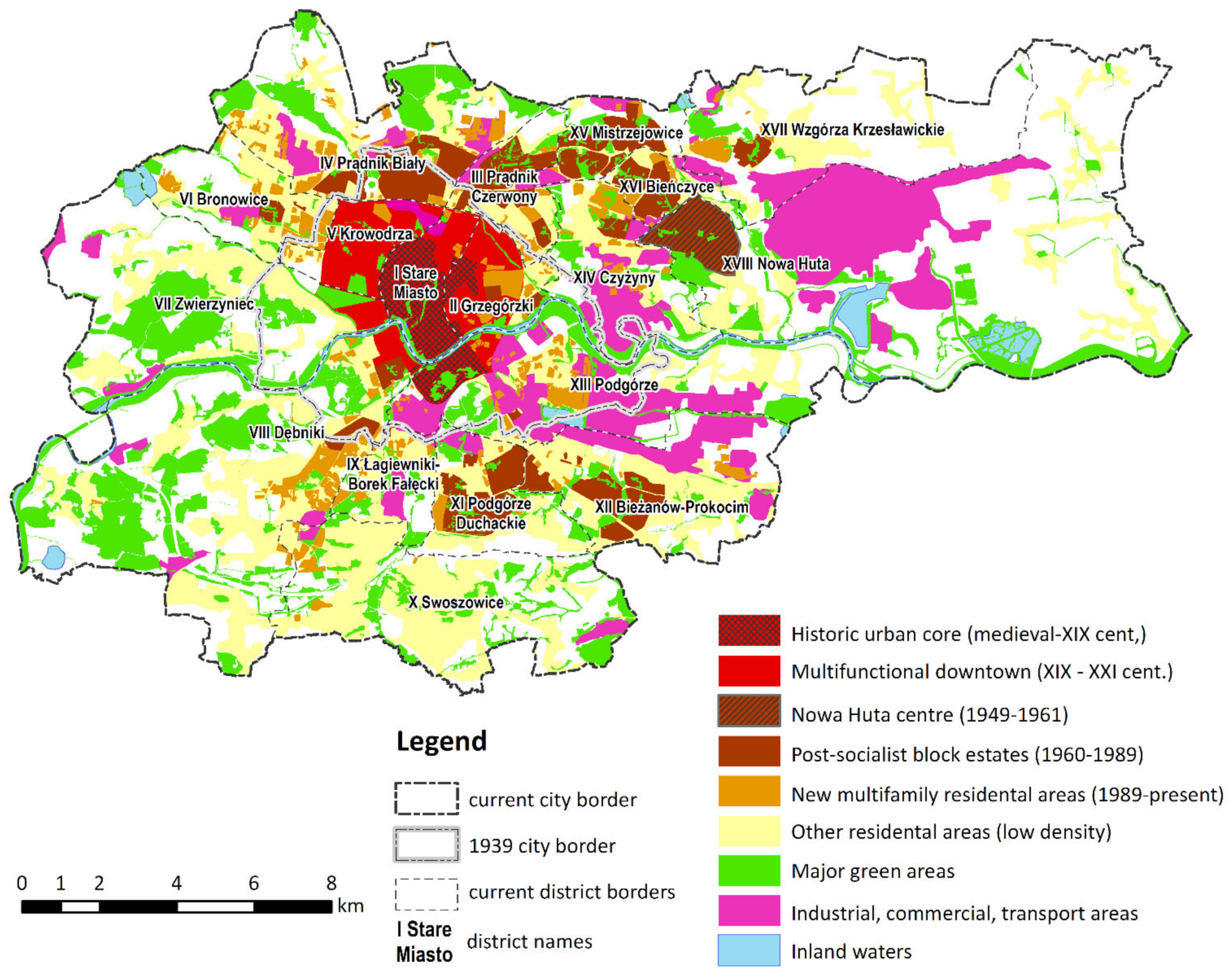
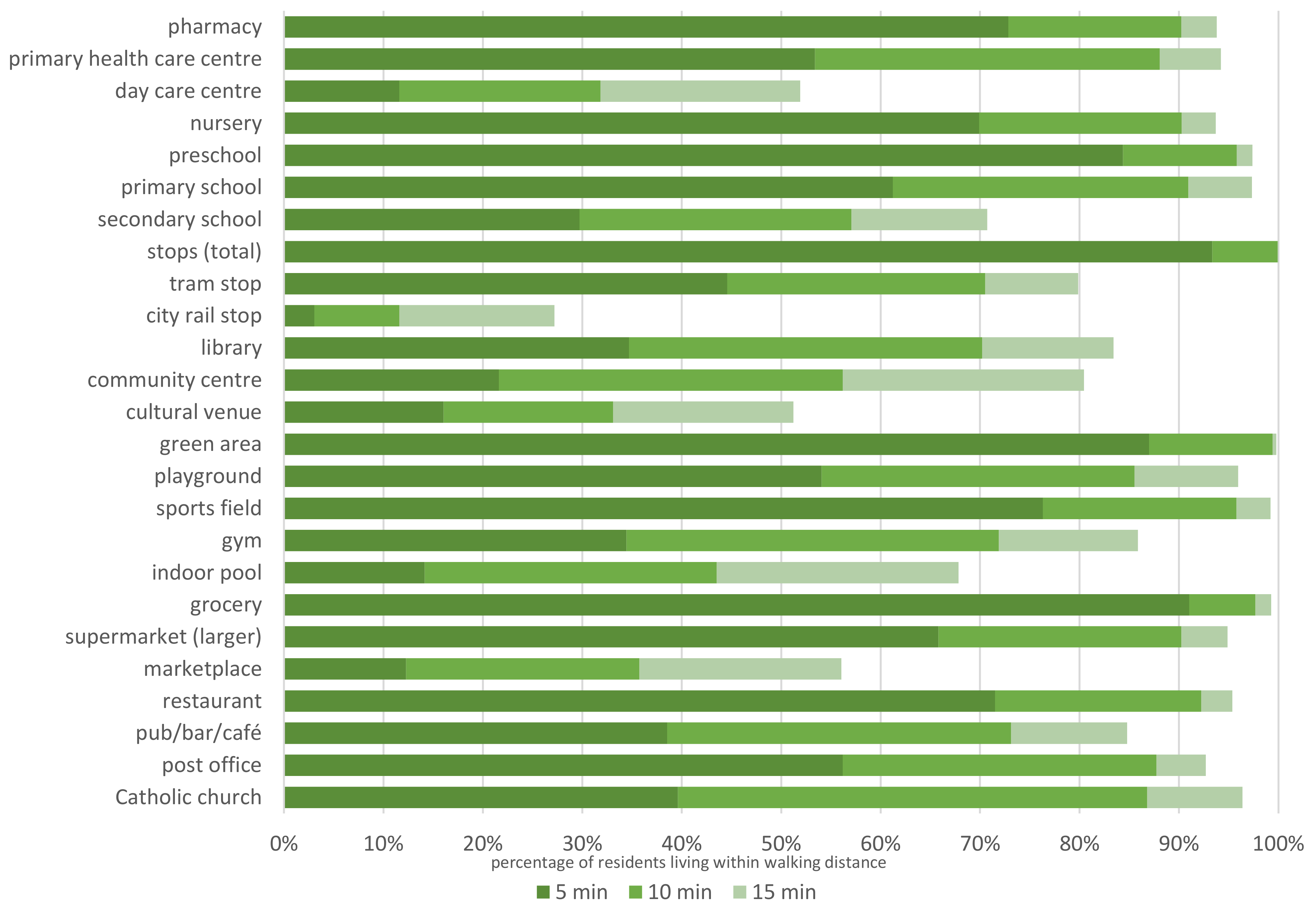

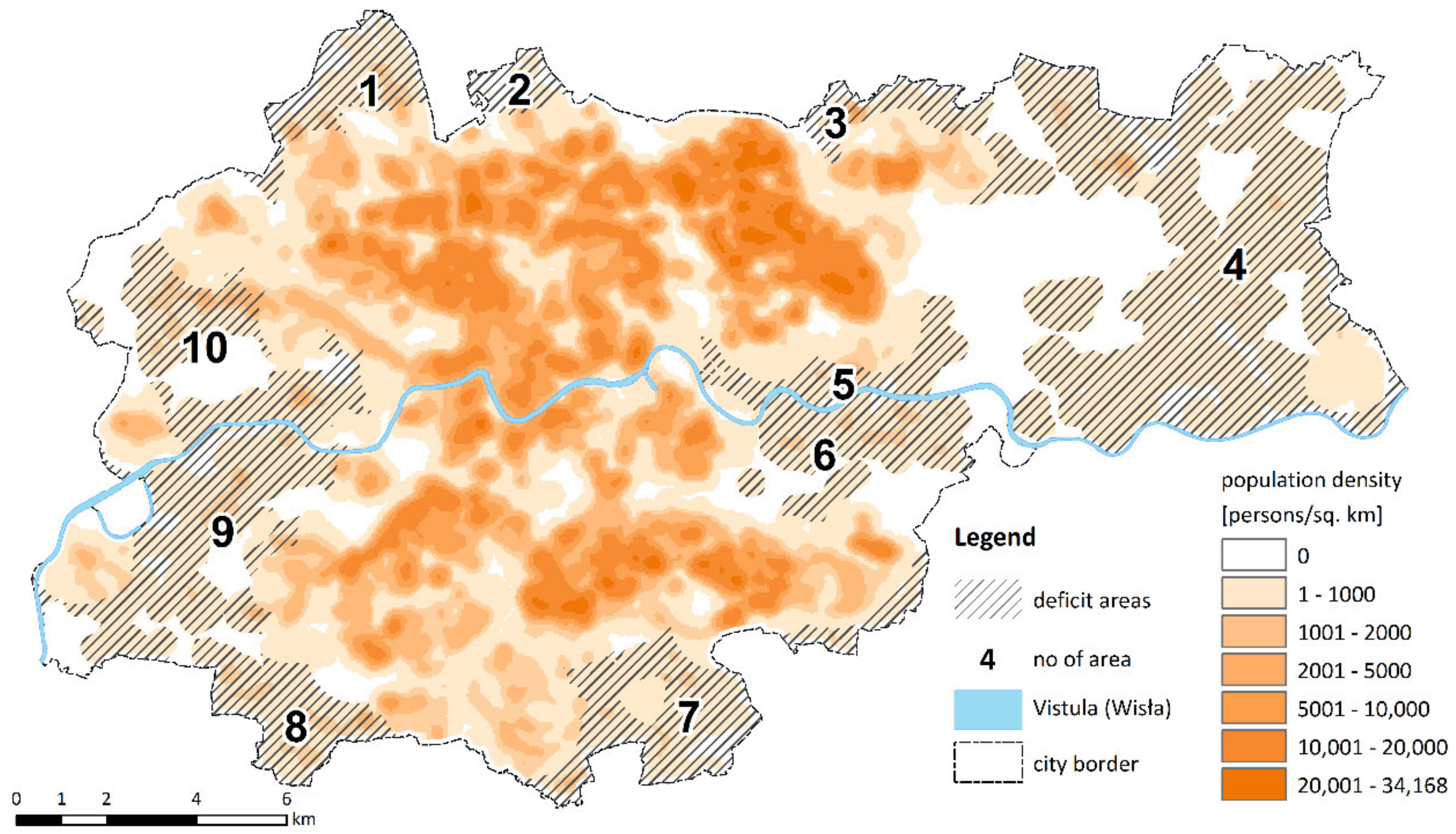
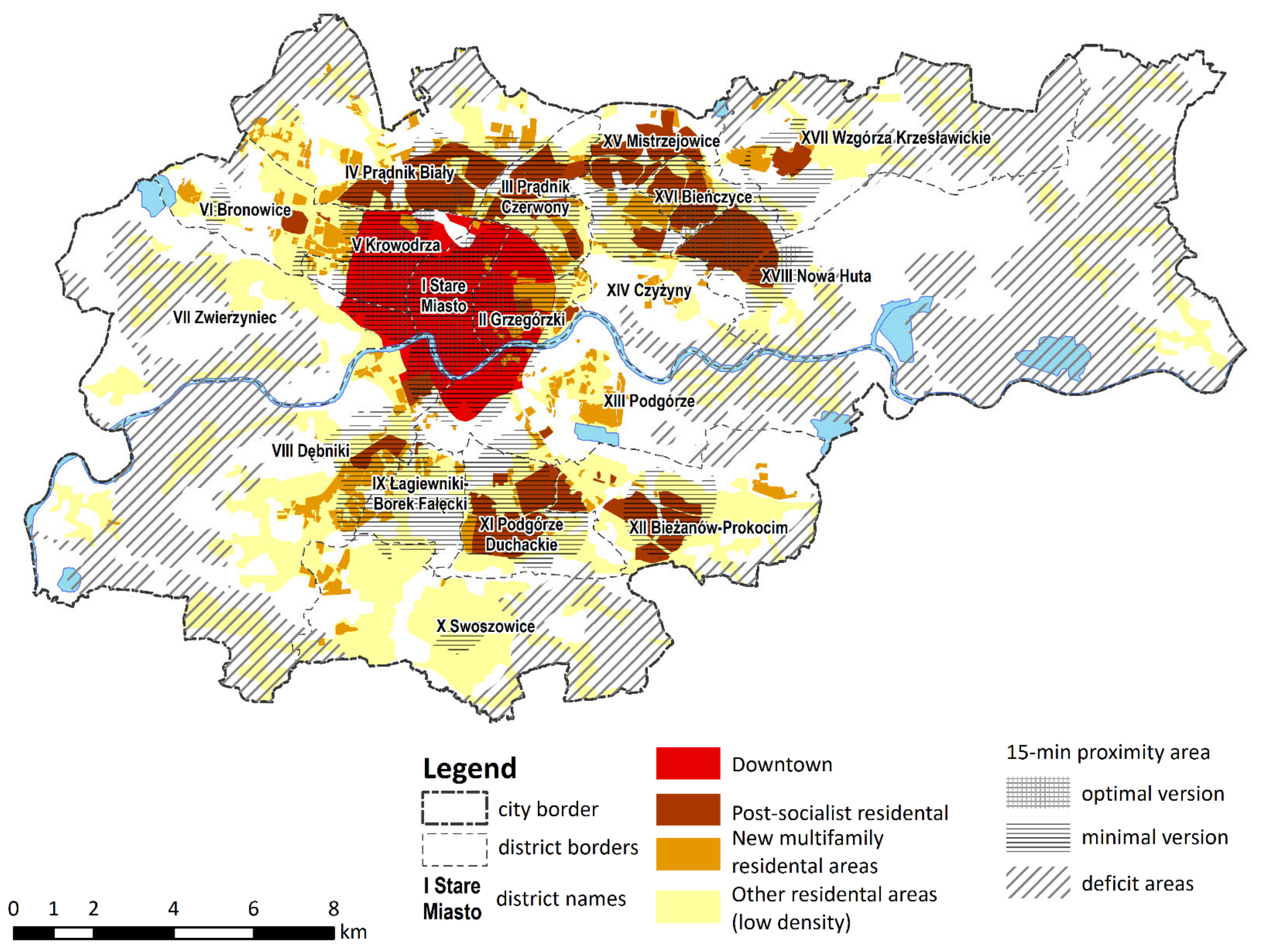
| Category of Needs | Facility | Data Source, Access Date | |
|---|---|---|---|
| 15-Minute City (Minimal Version) | 15-Minute City (Optimal Version) | ||
| Education and childcare | nursery | nursery | MSIP, 31 July 2021 |
| preschool | preschool | ||
| primary school * | primary school * | ||
| secondary school * | |||
| Health care | primary healthcare centre | primary healthcare centre | MSIP, 31 July 2021 |
| pharmacy | pharmacy | ||
| day care centre | |||
| Culture | library | library | MSIP, 31 July 2021 |
| community centre | community centre | OSM Krakow’s BIP www.bip.krakow.pl/?sub_dok_id=644, 3 August 2021 | |
| cultural venues: cinema, museum, concert hall, theatre, art gallery (collectively) | OSM Krakow’s website www.krakow.pl/kultura/35702,artykul,katalog_instytucji.html, 13 August 2021 | ||
| Green areas, recreation and sports | green areas with an area of 2 ha | green areas with an area of 2 ha | Directions for the development and management of green areas in Krakow for 2019–2030; OSM and https://krakowwzieleni.pl, 23 August 2021 |
| playgrounds for children | playgrounds for children | MSIP, 5 August 2021 | |
| communal sports fields for team games | communal sports fields for team games | OSM Krakow’s website www.krakow.pl/instcbi/247778,,2589,3,wyszukiwarka.html, 18 August 2021 | |
| indoor gym/fitness club | indoor gym/fitness club | ||
| indoor swimming pool | |||
| Shopping and services | grocery shop (any) | food supermarket (larger shop) | OSM Websites of retail chains, 26 August 2021 |
| post office | post office | OSM https://placowki.poczta-polska.pl, 5 August 2021 | |
| Catholic church | Catholic church | OSM, 7 May 2021 | |
| market square | |||
| restaurant | |||
| pub/café | |||
| Public transport stop (access on foot within 10 min) | any type | tram | MSIP Centroids of groups of same-name stops, 31 June 2021 OSM—rail stops (excluded from proximity area) |
| Area No | Deficits |
|---|---|
| 1 | preschool, primary school, primary health care centre, pharmacy, playground, gym/fitness club, post office |
| 2 | primary health care centre, pharmacy, library, community centre, gym/fitness club, post office |
| 3 | nursery, preschool, primary school, primary health care centre, pharmacy, library, gym/fitness club, post office, church |
| 4 | nursery, preschool, primary school, primary health care centre, pharmacy, library, community centre, playground, sports field, gym/fitness club, shop, post office |
| 5 | preschool, primary health care centre, pharmacy, library, community centre, gym/fitness club, post office |
| 6 | nursery, preschool, primary health care centre, pharmacy, library, playground, gym/fitness club, post office |
| 7 | nursery, preschool, primary school, primary health care centre, pharmacy, playground, gym/fitness club, post office |
| 8 | pharmacy, library, community centre, playground, gym/fitness club, post office, crèche |
| 9 | nursery, preschool, primary health care centre, pharmacy, library, community centre, playground, gym/fitness club, shop, post office, church |
| 10 | nursery, primary health care centre, pharmacy, library, playground, gym/fitness club, post office |
Publisher’s Note: MDPI stays neutral with regard to jurisdictional claims in published maps and institutional affiliations. |
© 2022 by the authors. Licensee MDPI, Basel, Switzerland. This article is an open access article distributed under the terms and conditions of the Creative Commons Attribution (CC BY) license (https://creativecommons.org/licenses/by/4.0/).
Share and Cite
Noworól, A.; Kopyciński, P.; Hałat, P.; Salamon, J.; Hołuj, A. The 15-Minute City—The Geographical Proximity of Services in Krakow. Sustainability 2022, 14, 7103. https://doi.org/10.3390/su14127103
Noworól A, Kopyciński P, Hałat P, Salamon J, Hołuj A. The 15-Minute City—The Geographical Proximity of Services in Krakow. Sustainability. 2022; 14(12):7103. https://doi.org/10.3390/su14127103
Chicago/Turabian StyleNoworól, Aleksander, Piotr Kopyciński, Paweł Hałat, Jeremiasz Salamon, and Artur Hołuj. 2022. "The 15-Minute City—The Geographical Proximity of Services in Krakow" Sustainability 14, no. 12: 7103. https://doi.org/10.3390/su14127103
APA StyleNoworól, A., Kopyciński, P., Hałat, P., Salamon, J., & Hołuj, A. (2022). The 15-Minute City—The Geographical Proximity of Services in Krakow. Sustainability, 14(12), 7103. https://doi.org/10.3390/su14127103






